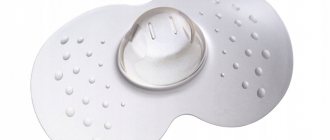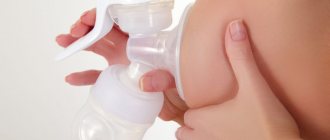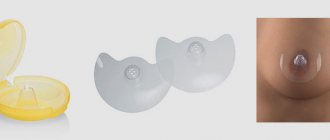A way to gradually stop breastfeeding over 2 to 3 weeks
Start cleaning up one feeding after another, one at a time. Make sure they are distributed evenly throughout the day. When only two feedings remain, they can be stopped at the same time.
The advantages of this method are the prevention of mastitis, the opportunity for you and the child to get used to the changes.
Instant weaning method
How to wean a child from breastfeeding when there is no time? In this case, you need to follow several rules:
- express milk (below we tell you how to do this);
- Apply cold compresses to your breasts to relieve pain and reduce blood circulation in the area and milk production; when the compresses get hot, change them;
- if the pain is too severe, consult your doctor about what painkiller you can take;
- drink enough fluids, don't worry - this won't increase milk flow;
- check your breasts for mastitis - it may be indicated by redness, swelling and increased temperature in some area of the breast; as a rule, this goes away if you gently press on the problem areas, pushing the milk out of the breast;
- you can apply cabbage leaves to your chest - this proven method has a scientific basis; refrigerate them before use and exchange them for cold ones after they warm up;
- do not overtighten your breasts - this leads to mastitis and lactostasis; try to avoid medicinal cessation of milk production; such medications have many contraindications.
The advantage of this method is that it makes it possible to quickly wean the baby from the breast.
At the stage of completion of breastfeeding, to exclude mastitis, the temperature should be measured in the elbow, and not in the axillary region, because here in a woman during lactation it will be higher than the average body temperature. This is a variant of the norm.
The natural way
How to wean your baby when he is ready? If your baby is ready to stop breastfeeding, you should do the following:
- after he receives the next portion of breast milk, offer him some complementary foods to arouse his interest and emotionally connect complementary foods with feeding;
- when the baby eats enough complementary foods and you see changes in the stool, the time comes to shift the emphasis - now, before each breastfeeding, try offering the baby complementary foods;
- breastfeed him not every 3 hours, but once every 5 to 6 hours. During other “sessions,” offer your baby baby water in a soft bottle or complementary foods. A child over 12 months old can be given warm cow's milk, preferably special baby milk;
- It’s worth saving morning feeding until the last minute (to prevent mastitis - after all, a large amount of milk accumulates in the breast during the night) and evening feeding, before bedtime (this will calm the baby and help him sleep soundly);
- how to wean a child from the breast if he cries at night and demands the breast? When feeding is completed, do not stand up when the baby cries; let another close person approach him at this time;
- do not refuse feeding, but do not offer it either;
- Make sure your baby has enough food and drink to meet all his needs.
This method is assessed by experts as more preferable. Its advantage is that it is the least “traumatic” for mother and baby when breastfeeding ends.
Cross cradle
This is one of the best breastfeeding positions for beginners. Sit upright in a chair or comfortable chair with armrests. Bring the baby towards you, across your stomach, so that his stomach touches yours. Hold the baby with one hand - opposite the nursing breast. If you feed with your left breast, it will be your right hand, with your right, it will be your left hand. Support the child's head with the palm of the same hand, leaving the thumb. With your other hand, grab your chest from below. The palm and thumb are positioned like the Latin letter U, in which the chest lies. Direct your baby's mouth toward the nipple without leaning forward or hovering over your baby. This is a good position if your baby has difficulty latching because this position will allow you to comfortably guide your baby's head into your palm.
How to properly end pumping
At this stage, you need to express milk only with your hands. If you use a breast pump, milk will continue to come out at the same rate, as it is too similar to the sensation of feeding a baby. It is important to finish pumping gradually, especially if you have been doing it consistently.
- Use your hands to compress your breasts and express milk to stop pain in the area caused by the pressure of the milk. To avoid stimulating its production, do this very carefully.
- Do not express all the milk, but only most of it to feel relief.
- First, day by day, reduce the number of pumping sessions, bringing it to two with 12 hours between them.
- At this point, reduce the time of each pumping session.
- Then do only one pumping per day, shortening the duration.
- If you reach a point where you can only express a few tablespoons of milk, you can stop pumping completely.
- Warm showers encourage pumping, but if taken consistently, they can have the opposite effect and encourage more milk to be produced.
What to feed your baby after finishing breastfeeding? This issue is resolved individually after consultation with a pediatrician and monitoring the child’s behavior. Breastfeeding can be used to replace one or more feedings during the period of completion of breastfeeding.
How to feed a mother who is finishing feeding
Immediately after finishing feeding, you should not include all prohibited foods in your diet, including sweets, alcohol and fatty foods. The fact is that this process is accompanied by physiological changes - hormonal changes, which are stress for the body. Additionally, you still need to replenish the micro- and macronutrients lost during breastfeeding.
How long will the restructuring period last?
Doctors believe that the body takes 2 to 6 months to return to its normal rhythm. All this time, if possible, you should adhere to approximately the same recommendations regarding nutrition and lifestyle as during breastfeeding. The first sign that your body is returning to its previous rhythm will be a restored menstrual cycle. It is also worth taking general tests and consulting with a gynecologist to confirm this information.
What diet should mom follow?
It is worth remembering that both unhealthy food and drinks and radical diets for weight loss are equally contraindicated for you. Both are additional stress for the body. Continue to eat the healthiest foods possible, supplement your diet with healthy baby food, and drink plenty of fluids: unsweetened compotes, still water, and fresh juices.
Cradle
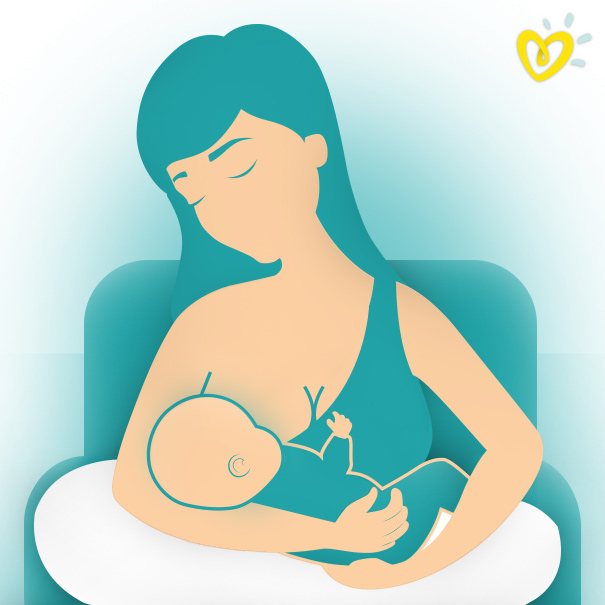
Unlike the cross cradle, in this position you support the baby with whichever breast you are feeding (feed with your right breast - the baby lies on your right hand). Sit upright in a comfortable chair with arms or in an armchair, with your baby's head resting in the crook of your elbow and his mouth against the nipple. Make sure your baby's head is in line with his body and not turned to the side. For comfort, you can place a pillow on your knees.
Armpit Pose

The armpit pose, also called the underarm pose, is well suited for women after a caesarean section and those with large breasts. In this position, the baby's weight does not rest on the mother's belly. With your elbow bent, hold your baby in front of you at waist level. Support your baby's head with an open palm, turning his head toward your chest. A child in this position seems to be looking out from his armpit. With your free hand, grab your breast so that your fingers are underneath the nipple and your thumb is on top, forming a C. This position is also good for feeding premature babies.
Correct placement of the baby to the breast.
A must read for pregnant women!!!
here is a video with correct application
When I start talking about the correct or incorrect way to attach a baby to the breast, I very often hear the following phrase: “What do you mean? Is it possible to breastfeed incorrectly? When I first started working as a lactation consultant, I was especially upset if I heard this phrase from the maternity hospital medical staff...
Breastfeeding is a very delicate thing. 20-30 minutes after birth, when the newborn has a desire to suck, the baby begins to look for the breast, opens his mouth, makes nodding movements with his head and tries to crawl towards the nipple. And at these moments, when the child’s instinctive sucking activity has not yet been spoiled by anything, only 30% of children grasp the breast correctly and begin to suck productively! The rest need help, breastfeeding several times before the attempt can be called successful.
In most Russian maternity hospitals, no one attaches the baby after the relaxation phase
. Immediately after birth, the baby’s umbilical cord is cut, shown to the mother, and taken away for “processing.” In the best case, the baby will see his mother in 2 hours, and most likely in 6-12 hours. The mother is usually told that the baby is resting after childbirth; he is not in the mood for sucking now. At this time, the baby is usually given water or formula from the nipple 1-2 times. This is called pre-breastfeeding, which often develops the habit of sucking on the nipple rather than the breast. Doctors and nurses usually protest and say: “What nonsense, it’s okay, then he’ll suck the breast, it won’t go anywhere.” In my experience this is not entirely true.
When I come to the postpartum department, I constantly meet children aged 2-3 days of life who do not even try to suckle the breast if it gets into their mouth. The baby demonstrates active searching behavior, opens his mouth, turns his head, and sometimes shouts. If I try to latch onto him, he opens his mouth wide, but doesn't try to start sucking. It happens that a child immediately begins to cry as soon as the breast is put into his mouth. A very common situation occurs when a child simply stops opening his mouth wide during searching behavior. This behavior is typical for children who have had experience sucking a pacifier or pacifier.
This “wonderful” picture is often observed: a mother sits over a plastic maternity hospital crib, admiring the peacefully sleeping baby sucking on a pacifier with the words “I love you, mama” written on it. (Lately, such pacifiers are very common in Moscow). I ask my mother if the baby is breastfeeding, to which my mother replies that she tried to give it a couple of times, but somehow he wasn’t very good... The second day after giving birth...
Usually, when I start telling my mother that if you periodically let the child suck on a bottle with a nipple, the child may refuse to breastfeed, the mother says: “Yes, it’s easier to suck from a bottle. And here (in the maternity hospital) the holes are so big.” Meanwhile, the point is not at all in the holes, and not in the ease of sucking.
The thing is that when sucking a pacifier, the child makes fundamentally different movements. It is actually easier to suckle at the breast, since the baby is “helped” by a reflexive process in the mother’s body, which contracts the smooth muscle cells around the gland lobules and pushes milk into the duct. Thanks to this reflex, milk is injected into the baby's mouth.
It should be noted here that the baby needs to suck in order to get rid of the feeling of discomfort. It doesn’t matter to a child what he sucks; everything is determined by habit. There is a widespread misconception that if a baby is given the breast first and then a bottle, the baby will not refuse the breast. Many mothers also believe that if you give your baby only water, tea or juice from a bottle, the baby will not refuse the breast. In fact, it doesn’t matter at all when and in what quantities he sucks on a pacifier or pacifier. There are children for whom it is enough to suck the pacifier 1-2 times to have problems with breastfeeding. There are babies who “suddenly” begin to act up at the breast at 2-3 months. There are children who happily suck whatever they are given, but gradually stop gaining weight.
The World Health Organization, in its bulletin on infant feeding, speaks on this issue as follows:
“In a normal newborn, the sucking reflexes necessary for breastfeeding are quite strong at birth. Practice confirms that some children born at the 32nd week of pregnancy weighing only 1200g are able to effectively breastfeed
even
before they learn to suck from artificial nipples.
However, these crucial reflexes may be weak or absent in cases of too early termination of pregnancy, in babies with extremely low birth weight, and in sick babies... ... However, the most common reasons for the reduced effectiveness of these reflexes are the use of sedatives or painkillers during pregnancy. childbirth
and postpartum learning interventions
.
The child's instinctive movements must be consolidated into correct behavior during the postpartum period.
Using other oral objects, pacifiers, or pacifiers during this period may expose the baby to other oral movements that are inappropriate for breastfeeding. …. For successful establishment of breastfeeding, factors that reduce the duration, efficiency and frequency of breastfeeding by a child must be eliminated by any available means. These factors include: limited feeding time, scheduled feeding, awkward feeding positions, use of other oral objects, and the baby receiving other liquids such as water, sugar solutions, vegetable or animal milk products.”
For the formation of full lactation in the mother, for long-term and successful breastfeeding, the importance of proper attachment is enormous.
Only with proper attachment does the baby stimulate the breast to produce sufficient milk. Only with proper attachment can the baby suck out as much milk as he needs. Only correct attachment will not cause any discomfort in the mother during feeding and will never lead to the need to interrupt feeding due to painful sensations, because they simply won't exist.
What is proper latching of a baby to the breast?
The baby should grasp the nipple and areola with a vigorous “butting” movement of the head, lifting the breast, and then, as if placing it as the breast moves down, onto a wide-open mouth, with the tongue lowered but not protruding under the breast. It is necessary that this grip be complete and deep so that the nipple is in the child’s mouth almost at the level of the soft palate, i.e. The nipple and areola should actually fill the entire oral cavity of the child. For such a grip, a very wide-open mouth is required, and if the baby is unable to immediately open his mouth correctly, then you can help the child by running the nipple along his lower lip, causing a reflex movement of the lips and opening of the mouth. Often the baby's first reaction to the mother's breast will be to lick it and only then grab it.
With correct latching on the breast, the child maintains a wide open mouth, the lower lip is completely inverted (it is pushed out by the front edge of the tongue lying on the lower jaw). The areola fits completely into the baby's mouth if it is small. If the areola is large, then its capture is almost complete, asymmetrical. From below, the child captures the areolas more than from above.
The effectiveness of sucking is determined not through the creation of negative pressure, but through a rhythmic massage of the areola, carried out by the movements of the child’s tongue.
A child sucks a bottle of any shape and with any hole size in the same way as an adult sucks from a straw: by creating negative pressure. The tongue is not involved in sucking from a bottle. There are no milking movements of the tongue. The tongue is usually located behind the lower jaw. Therefore, when a baby who is accustomed to sucking a bottle gets into his mouth, he does not know what to do with it. In the extreme case of improper attachment, the nipple gets caught between the jaws, and the baby sucks on the breast just like a bottle. If the nipple is between the jaws, the mother usually experiences quite strong discomfort. The severity of pain depends on the thickness of the skin of the areola and the individual sensitivity of the woman. But in any case, the nipple is injured very quickly and often already on the second day after birth, if the attachment is incorrect, abrasions appear, which turn into cracks if the attachment is not corrected. This situation is so common that many women consider cracking to be a necessary evil that comes with breastfeeding.
The painless option of incorrect application turns out to be very “insidious” .
In this case, the nipple itself falls behind the jaw and lies on the tongue along with a small part of the areola. The child expresses it... In this case, it does not hurt the mother, because... The baby does not bite the nipple. The baby even gets some milk. But the breasts do not receive enough stimulation and do not empty well. This gradually leads to a decrease in milk supply. Usually the child in this case does not gain weight very well. Or there is a gradual decrease in the increase. For example, in the first month the child gained 900 g, in the second - 600, in the third - 450. If the child is somatically healthy, feeds on demand, does not suck on anything except the breast, then most likely there is a painless variant of improper attachment.
If a woman has never seen how a baby should suck, if no one has shown her how to properly give the baby the breast and how he should suck, how to control the quality of attachment during sucking, there is a very high probability that she herself will not latch the baby quite correctly and not will be able to teach him the correct behavior at the breast. She doesn’t know that she needs to learn something here...
In those distant times, when breastfeeding in our society was commonplace, and not a rare exception, every woman could help a mother who was starting to breastfeed, correct her mistakes, and show her the necessary techniques.
Currently, most women do not have the opportunity to learn motherhood practically. Many people read various magazines or books for parents, and then try to care for and feed their baby based on the theoretical knowledge they have acquired.
Unfortunately, it is impossible to learn how to properly attach a baby to the breast from books, magazines and pictures. Practical training is required. In maternity hospitals, where most modern babies are born in industrialized countries, no one is engaged in such training. The vast majority of health workers do not have the necessary knowledge for this. What is needed to successfully teach another woman is first and foremost a positive personal experience with breastfeeding. Nurses and midwives, like most modern women, do not have such experience. Incorrect attachment, being widespread, does not cause any concern on the part of medical staff. Women are given only routine recommendations for healing abrasions or cracks, if any. If the baby and mother have a painless incorrect attachment and the associated lack of milk, then the problem is solved by prescribing supplementary feeding and ends with a rapid transition to artificial feeding, because supplementary feeding is given from a bottle with a nipple. The problem of improper attachment is accompanied by breast refusal.
What should a woman do when putting her baby to her breast?
Try to find someone who knows how to breastfeed. let it be a mother who is not breastfeeding her first child, who monitored the quality of attachment, who fed for a long time, who does not use nipples or pacifiers, who has never had and does not have problems with nipples (abrasions, cracks). Observe how she gives the breast to her baby and how her baby sucks. This could be your roommate.
If you experience unpleasant or painful sensations while sucking your baby, and the medical staff cannot correct anything with their manipulations, try to find a mother who does not experience discomfort when feeding and consult with her.
The best option for the mother is when she is taught how to latch on by a woman who has extensive practical experience and knows how to distinguish between different latch options for different nipple shapes.
For example, at first glance at two nursing roommates, especially from a distance of one meter, it may seem that one mother is doing well, while the other’s latch is not very deep. But upon closer examination, it turns out that the first mother’s grip was insufficient, although it does not hurt the mother, the child is actually licking the nipple and the mouth is not open wide enough. The baby will need to be retrained and the mother will need to monitor the quality of attachment. In another case, it turns out that although the baby has a very small mouth and the mother has a large nipple, the baby sticks out his tongue very well, positions it correctly and expresses the breast perfectly.
When latching your baby, try to follow the general recommendations:
1. Place your breast into your baby's MOUTH WIDELY OPEN ONLY! Do not try to push the nipple into the half-open mouth; most likely, the child will clamp it with his jaws or he will not take it deep enough.
2. Try to act quickly, because... The child holds his mouth wide open for a second or two. If you didn't have time, wait until next time. Help your baby open his mouth by running the nipple along his lower lip several times in a row.
3. Be patient. Very often I observe such mother actions: the mother takes the baby, tries to attach him, the child displays active searching behavior, turns his head. Mom says: “He doesn’t want to!” The mother perceives the child’s instinctive behavior aimed at searching for a nipple as a negative response from an adult! Or, for example, it very often happens that when a mother touches the child’s lower lip with her nipple, he squeezes his mouth. Mom again immediately says that the baby does not want to suck. Meanwhile, if she continued the sentence, the baby would definitely open his mouth. After all, the child does not yet understand what they want from him. He doesn't know that he is expected to open his mouth. For most children, it takes at least two weeks to develop a stable skill of correctly latching onto the nipple, in response to their mother’s suggestion!
4. Very often, having grabbed the breast correctly, the baby, while sucking, slides to the tip of the nipple and begins to bite it. Mom experiences painful sensations, but she tolerates them. Painful sucking is unacceptable! The baby does not know that he is sucking incorrectly! He needs to be taught how to suck properly. If the baby begins to slide onto the tip of the nipple, the breast must be correctly picked up (opening the baby's jaws, quickly putting the tip of the finger in the corner of the mouth) and re-introduced.
5. Usually the baby slides onto the tip of the nipple if, while sucking, it does not touch the breast with its nose. Most maternity hospitals recommend holding your breast above the nose with your finger to make breathing easier. But the baby feels the breast with his face! He should touch the breast with his nose while sucking. This position should be maintained throughout sucking and at any age of the baby. If he does not touch his nose to the breast, the newborn does not know that he is already in “place”, and may make searching movements with the nipple in his mouth! His mother immediately says that the baby does not want to suck. The baby’s nose is designed in such a way that the tip makes a “hole” in the chest and breathes through small triangular slits at the wings of the nose. Therefore, there is no need to hold the breast with your finger above the spout. Not only does this maneuver spoil the application, it also contributes to the occurrence of lactostasis in the upper lobes of the gland, because Mom pinches the ducts with her finger and makes it difficult for milk to flow out.
The baby should not be allowed to pull back the nipple or pass it back and forth between the jaws. It is necessary to hold the head when trying to retract the nipple. And take away the breast if the baby begins to “play around”, causing pain to the mother. An older child should not be allowed to turn his head with the nipple in his mouth if he wants to look at some object. The baby should follow the object of interest only with his eyes. Or he should let go of his chest and turn his head if he needs it.
6. Separately, I would like to note the “inconvenient” nipple shapes - flat nipples, inverted, long, thick. Any newborn who is able to suck can adapt to any shape of his mother's nipple. A mother who has a nipple of an “unconventional” shape should show more patience and persistence in teaching her child to suck properly. And she should try to ensure that her baby never receives other “oral objects”, because... In any case, they will seem more convenient for sucking than the mother's breast.
7. For a mother with flat and inverted nipples, the moment the baby draws the breast into the mouth is very important. If a baby gets a bottle, pacifier or pacifier in his mouth, he stops making a retracting movement. Both the nipple and the pacifier are already extended, they do not need to be retracted further. Therefore, when the baby gets his mother’s flat nipple in his mouth, he simply opens his mouth and waits, without trying to suck it in. A mother with flat or inverted nipples should try to prevent other sucking objects from getting into the baby's mouth. If necessary, you can give supplementary feeding or your own expressed milk from a spoon, syringe or pipette.
If a mother has long and/or large nipples, it is very important for her to place them in her mouth as deeply as possible, bringing the nipple itself past her jaws. In the case of a long nipple, the child very often closes his jaws on the nipple or immediately behind the nipple. The areola practically does not enter the mouth, the baby does not express it, it turns out that he simply licks the nipple. He cannot express milk this way; the breasts are not emptied or stimulated. There is a shortage of milk. A large nipple cannot be placed in an insufficiently open mouth. The baby, after sucking a pacifier or pacifier, stops opening his mouth wide, because... To suck these objects there is absolutely no need to open your mouth wide.
A child with the smallest mouth can suck on his mother’s breast with the largest or longest, or any other “inconvenient”, from our point of view, nipple. You just need to place the breast in your mouth correctly, be patient and persistent. Just everything.
In conclusion, I would like to say that by teaching a child to breastfeed correctly, the mother provides him with complete, ideal nutrition in the future, and for herself long-term stable lactation.
Liliya Kazakova, pediatrician, breastfeeding consultant of the Moscow public breastfeeding support group “Mothers for Breastfeeding”
Lying on your side
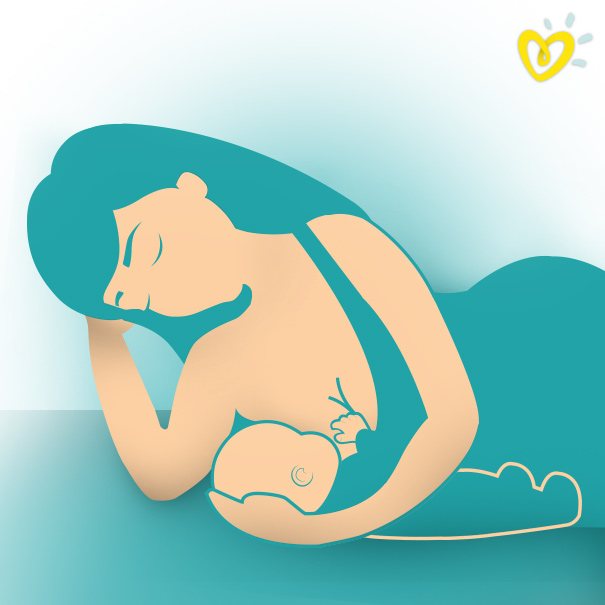
If you are tired after childbirth or are half asleep, you can feed while lying down, but it is important not to fall asleep. Side-lying feeding rather than sitting up is a good option after a caesarean section. Lie on your side and place your baby at your chest, supporting him with your hand. With your other hand, grab your breast and touch your nipple to your baby's lips. As soon as he grabs your chest, you can extend your arm or put it under your head, and with your other hand you can hug the baby.
How can you help your child overcome this period?
How to wean a child from breastfeeding? Distract him. If he's used to getting mommy's milk when he's tired or when you're lying down together, offer him a drink, play with him, or read to him out loud so he can satisfy his cravings in a new way.
- Try not to sit in the places where you usually breastfeed your baby.
- Change the daily routine so that there are changes in it and the baby does not want to be fed in familiar places at the usual time.
- Rearrange the furniture in the room where you usually breastfed your baby.
- Ask your loved ones to help you distract your baby.
- If your baby has become especially attached to his blanket or toy during this period, do not interfere with this - this way you will help him create a new emotional connection, now not only with the feeding situation.
Be patient. Children always experience this situation hard, and their irritability may increase. All this is temporary.
We wish you successful completion of breastfeeding!




